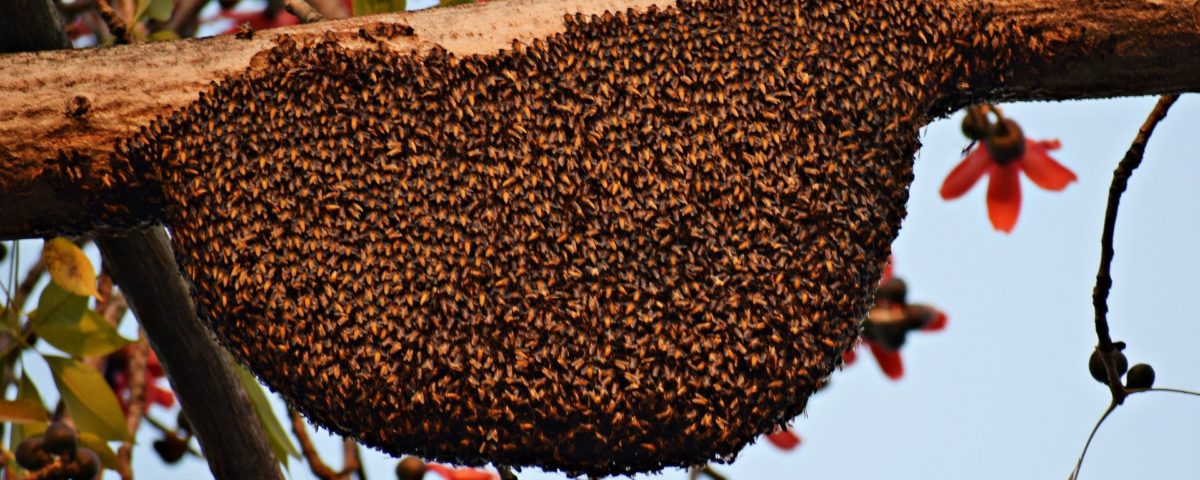- All-In-One Beekeeping for the Bees
- +1-608-728-8233
- info@beepods.com
Why Nonreproductive Swarms Happen: They’re Not a Bad Thing!


Nonreproductive swarms can cause some serious head-scratching for beekeepers. When more than half of your colony has flown the coop at a time of year you’re not expecting them to swarm, you might be wondering what they’re up to and why. Once you’ve heard what drives bees to nonreproductive swarming, though, you’ll probably sympathize with them (at least a little).
Imagine a pest completely infested your home, or that your roommates were super sick and contagious. You’d probably grab your bags and hit the road, right? When bees swarm during nonreproductive months, they’re saying “Hasta la bee-sta!” to their hive and heading out in search of a safer, healthier home.
Keeping Everyone Healthy
Nonreproductive swarming is a way for a colony to preserve its legacy and survive long-term. A lot of times they’ll do it to protect the colony from pathogens (viruses, bacteria, and fungi) and parasites, huge threats to bees. Bees can’t exactly fight off those sometimes-microscopic bad guys. Moving around and changing their behaviors – and their location – is their most effective way to defend themselves. Nonreproductive swarming also helps bees avoid some pathogens and parasites all together. By steering clear of areas and spaces where those tiny jerks are lurking around.
Varroa Bee Gone
Varroa mites – you know, those vicious little parasitic arachnids that can wreak havoc on an otherwise healthy hive – are one of the parasites that bees are trying to dodge with nonreproductive swarming. Varroa mites enjoy a big brood so that they have ample opportunity to reproduce. When 70% of a colony takes off with a nonreproductive swarm, they lose a lot of potential hosts.
Plus, the swarming bees might take up to 35% of the hive’s Varroa mites along for the ride. This gives their parent hive (and maybe their beekeepers) a chance to conquer the mites. So swarming can be a great, natural way to get rid of some of those pesky parasites.
(This nonreproductive swarm was caught on camera in Beijing!)
Creating a Healthier Gene Pool
Another reason bees cast nonreproductive swarms is to boost their colony’s genetic mix. This plays a pretty big role in their overall survival and productivity. A colony of bees with a healthy amount of genetic diversity isn’t as much fun for pathogens to prey on. When bees are super healthy, they recover faster from disease and evolve over time.
Worker bees in nonreproductive swarms are usually reproductive over-achievers and live a bit longer than other bees do. Swarming can give them an opportunity to take their show on the road and perpetuate the “good genes.” Swarming helps those ambitious little bees to avoid sexual partners back at their parent hive who might be carrying a bee STD – yes, that’s actually a thing.
Telling Swarms Apart
The easiest way to recognize whether a swarm is reproductive or nonreproductive is to pay attention to what time of year it is. Nonreproductive swarming usually happens outside of the common spring–summer reproduction season, typically after July. Those cooler months are prime time for pathogens and parasites to attack. It’s when colonies are most likely to suffer from infections and disease.
A nonreproductive swarm can look a lot like other swarms: A large group of bees will leave their hive and head out for the unknown. They’ll set up a temporary cluster quarters before ultimately finding new digs where they’ll build a home.
How to Manage a Nonreproductive Swarm
Once you’ve identified that a nonreproductive swarm is on the move, you have a couple of options as to how you can proceed. Whether it’s a swarm of your own bees, or one you’ve happened upon some other way, capturing the swarm and relocating them is something to consider. Check out our video on how to safely capture, transfer, and temporarily hold a swarm of honeybees using Beepods’ Harvest Box.
If the swarming bees aren’t yours, and if they aren’t presenting a problem for you (say, for example, by clustering around your front door), you can also go with the option of leaving them alone. The bees will move on soon enough and, unless they’re in a high traffic area, they probably won’t be a bother to anyone… As long as you don’t bother them. If you run into a swarm that needs some help, reach out to Beepods at 608-728-8233, or email us at beekeeping@beepods.com.
Parting Thoughts
While it’s too bad that the need for survival is what drives nonreproductive swarms out from their hives, when you think about it, these bees are doing the best they can do to keep their colonies going strong – and there’s something kind of inspirational about that!
Learn from the Pros!
Looking for beekeeping techniques and tips? Check out Beepods Lab for best practices, educational resources, and more.
Kanoe Riedel
Latest posts by Kanoe Riedel (see all)
- This Spring, Don’t Forget Why Bees Are So Important to Our Environment - March 26, 2021
- 11 Awesome Uses for Your Stored Honeycomb - March 2, 2021
- How the Right Beekeeping Equipment Makes Inspections Better for Beekeepers and Bees - February 12, 2021



